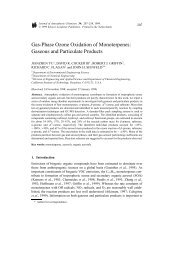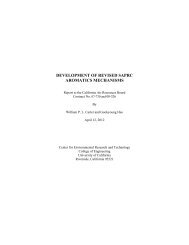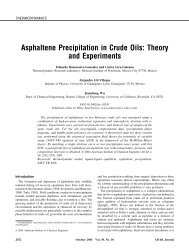Density functional theory for chemical engineering: From capillarity ...
Density functional theory for chemical engineering: From capillarity ...
Density functional theory for chemical engineering: From capillarity ...
You also want an ePaper? Increase the reach of your titles
YUMPU automatically turns print PDFs into web optimized ePapers that Google loves.
wetting and dewetting phenomena in polymeric systems. At the<br />
silicon surface with a thin oxide coating layer, DFT predicts<br />
that the surface free energy is everywhere positive relative to<br />
that of the bare surface or when the surface is in direct contact<br />
with the bulk liquid. In this case, the polymer partially wets the<br />
surface. When the surface is coated with a thick layer of oxide,<br />
on the other hand, a polymer film of finite thickness is stable,<br />
corresponding to the state of frustrated complete wetting. Below<br />
the frustrated complete wetting temperature, the mesoscopic<br />
film ruptures into small droplets. Prediction of “nanodewetting”<br />
is in good agreement with experiment. 165<br />
Effect of curvature on wetting<br />
DFT has also been applied to investigating the influence of<br />
substrate curvature on wetting transitions. 166-168 Unlike the<br />
planar case, complete wetting does not occur on a spherical<br />
particle where the thickness of the wetting layer grows only as<br />
the logarithm of the particle radius. 169 DFT predicts that at a<br />
spherical substrate, the contact angle declines with curvature,<br />
whereas the opposite holds <strong>for</strong> the wetting temperature. 170<br />
Solvation and Surface Forces<br />
In the development of modern solution theories, one key<br />
challenge is to understand the microscopic structure of solvent<br />
molecules near a solute (that is, solvation) and the solventmediated<br />
<strong>for</strong>ces. There has been a vast literature concerning<br />
solvation and solvation <strong>for</strong>ces. The following discussion is<br />
limited to a few cases relevant to recent applications of DFT to<br />
colloidal systems.<br />
Solvation at different length scales<br />
The presence of a solute in a liquid solvent introduces a local<br />
distribution of solvent molecules that is affected not only by<br />
solute–solvent interactions but also by the size of the solute.<br />
Although the effect of the solute–solvent interaction energy on<br />
solvation is well documented, the size effect is much more<br />
subtle, as first indicated by Stillinger more than 30 years ago. 171<br />
By separately considering the slow and fast-varying components<br />
of the local inhomogeneity using respectively the van der<br />
Waals’ square-gradient <strong>theory</strong> and Gaussian approximation (or<br />
quadratic density expansion), Lum et al. 172 demonstrated that<br />
the solvation of small apolar groups in water is different from<br />
that of large hydrophobic groups. In the <strong>for</strong>mer, hydrogen<br />
bonding of water is hindered yet persists near the solute. In the<br />
latter, hydrogen bonding is depleted, leading to drying of<br />
extended apolar surfaces and to long-range hydrophobic attraction.<br />
Accumulation of solvent molecules near a small solute, and<br />
depletion of solvent molecules near a larger solute has also<br />
been observed in simple fluids as represented by the hardsphere<br />
or Lennard–Jones (LJ) potential. 54,173 Figure 15 shows<br />
the distributions of LJ molecules in a stable liquid around an<br />
isolated hard-sphere solute of different sizes. 174 Even in the<br />
absence of solute–solvent attractions, solvent molecules may<br />
accumulate around a solute whose size is comparable to that of<br />
the solvent. The oscillatory local density distribution resembles<br />
the radial distribution function of the pure solvent (Figure 15).<br />
In this case, the solvation <strong>for</strong>ce is short range and mainly<br />
repulsive. With increasing solute size, however, the oscillatory<br />
Figure 15. <strong>Density</strong> profiles (r) of a Lennard–Jones (LJ)<br />
fluid around an isolated hard sphere of different<br />
sizes. 54<br />
Here b is the bulk density of the LJ fluid and S stands <strong>for</strong><br />
the size ratio, that is, the diameter of the hard sphere divided<br />
by . The symbols are simulation data, 281 and the solid and<br />
dashed lines are predictions of DFT. For clarity, the density<br />
profiles <strong>for</strong> S 1, 2, and 3 have been shifted upward by 2.4,<br />
1.6, and 0.8 units, respectively. [Color figure can be viewed<br />
in the online issue, which is available at www.interscience.<br />
wiley.com.]<br />
density profile rapidly fades away and a vapor-like layer is<br />
developed near the solute surface. The thickness of the vaporlike<br />
layer grows with solute size, leading to a long-range<br />
attraction. 175,176<br />
With an appropriate <strong>for</strong>mulation of the excess Helmholtz<br />
energy <strong>functional</strong>, agreement between DFT and molecular simulation<br />
is nearly perfect. 174 Results from DFT calculations also<br />
suggest that the depletion-induced surface attraction is substantially<br />
stronger than that expected from conventional Hamaker<br />
or Lifshitz theories. 175 In addition, DFT predicts that, in good<br />
agreement with molecular simulations but contrary to the standard<br />
Hamaker <strong>theory</strong>, in a fluid medium the attraction between<br />
two hard surfaces increases with temperature when the pressure<br />
is fixed, but at a fixed temperature, it falls as the pressure<br />
rises. 175 Because the van der Waals attraction between solute<br />
and solvent molecules is ubiquitous, even a weak solute–<br />
solvent attraction may lead to a large reduction of the vaporlike<br />
depletion layer. Nevertheless, the incipient presence of<br />
drying should play an important role in hydrophobic phenomena<br />
at large-length scales. 172,177<br />
Electric double layer<br />
The solvation of a charged particle in an electrolyte solution<br />
results in the accumulation of counterions and the depletion of<br />
co-ions. The charged surface, along with the neutralizing counterions,<br />
is called the electric double layer (EDL), which is of<br />
central importance in surface chemistry and colloid science.<br />
Although conventional wisdom suggests that the colloidal<br />
charges are only partially screened by the surrounding counterions,<br />
recent experiments and molecular simulations indicate<br />
that the overall charge of a macro-ion plus that of its surrounding<br />
counterions may have a sign opposite to its bare<br />
charge. 178,179 In contradiction to classical Derjaguin–Landau–<br />
Verwey–Overbeek (DLVO) <strong>theory</strong>, the electrostatic interaction<br />
between similarly charged colloidal particles can be attractive<br />
1182 March 2006 Vol. 52, No. 3<br />
AIChE Journal
















